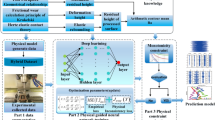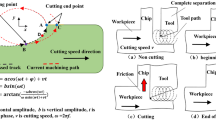Abstract
The surface finish quality is critical to the service performance of a machined part, and single-point diamond ultra-precision machining can achieve excellent surface quality for many engineering materials. This study studied the problem of predicting the surface roughness for titanium alloy workpieces in ultra-precision machining. Process data and surface roughness measurement results were obtained during end-face machining experiments. A deep learning neural network model was built based on the ResNet-50 architecture to predict surface roughness. We propose increasing prediction accuracy by using the energy ratio difference (ERD) as a stability feature that can be extracted using fast iterative variational mode decomposition (FI-VMD). The roughness value obtained with an analytic model was also used as an input feature of the prediction model. The prediction accuracy of the proposed approach was depicted to be improved by 8.7% with the two newly introduced roughness predictors. The influence of the tool parameters on the prediction accuracy was investigated, and the proposed hybrid-driven model exhibited higher robustness to errors of the tool parameters than the analytic roughness model.
Similar content being viewed by others
References
Li B, Li D, Shen W, et al. Research on turbine lamina roughness influence on its performance declination. Aeronaut Comput Tech, 2009, 39: 26–29
Kim J D, Nam S R. A piezoelectrically driven micro-positioning system for the ductile-mode grinding of brittle materials. J Mater Process Tech, 1996, 61: 309–319
Zhou M, Wang X J, Ngoi B K A, et al. Brittle-ductile transition in the diamond cutting of glasses with the aid of ultrasonic vibration. J Mater Process Tech, 2002, 121: 243–251
Xu X H, Ye S T, Yang Z Y, et al. Analysis and prediction of surface roughness for robotic belt grinding of complex blade considering coexistence of elastic deformation and varying curvature. Sci China Tech Sci, 2021, 64: 957–970
Wu D, Zhang D, Yao C. Effect of surface integrity of turned GH4169 superalloy on fatigue performance. J Aeronaut Mater, 2017, 37: 59–67
Wei X, Yue C, Hu D, et al. Research on surface roughness of supersonic vibration auxiliary side milling for titanium alloy. Chin J Mech Eng, 2022, 35: 101
Li C, Bhatta K, Xiao G, et al. Filling missing surface roughness data for grinding process using physics-guided neural network. Manuf Lett, 2022, 33: 828–834
Sung A N, Ratnam M M, Loh W P. Effect of wedge angle on surface roughness in finish turning: Analytical and experimental study. Int J Adv Manuf Technol, 2014, 74: 139–150
Vajpayee S. Analytical study of surface roughness in turning. Wear, 1981, 70: 165–175
Hocheng H, Hsieh M L. Signal analysis of surface roughness in diamond turning of lens molds. Int J Mach Tools Manuf, 2004, 44: 1607–1618
Zong W J, Huang Y H, Zhang Y L, et al. Conservation law of surface roughness in single point diamond turning. Int J Mach Tools Manuf, 2014, 84: 58–63
Ma L, Cai C, Bi C. Theoretical model of crack propagation behavior and fracture chip formation mechanism during turning of fluor-ophlogopite ceramic. Int J Adv Manuf Technol, 2018, 99: 2585–2596
Chen C, Lu J, Chen K, et al. Research on analytical model and DDQN-SVR prediction model of turning surface roughness. J Mech Eng, 2021, 57: 262–272
Rafei M, Ghoreishy M H R, Naderi G. Thermo-mechanical coupled finite element simulation of tire cornering characteristics—Effect of complex material models and friction law. Math Comput Simul, 2018, 144: 35–51
Liu Y W. Numerical simulation of the machining distortion of aircraft aluminum part caused by redistribution of residual stress. Adv Mater Res, 2010, 142: 122–125
Tao Z, Fan X, Yang H, et al. A modified Johnson-Cook model for NC warm bending of large diameter thin-walled Ti-6Al-4V tube in wide ranges of strain rates and temperatures. Trans Nonferrous Met Soc China, 2018, 28: 298–308
Ali M H, Khidhir B A, Ansari M N M, et al. FEM to predict the effect of feed rate on surface roughness with cutting force during face milling of titanium alloy. HBRC J, 2019, 9: 263–269
Li N, Li P, Song L. Effect of surface roughness in micro-nano scale on slotted waveguide arrays in Ku-band. Chin J Mech Eng, 2017, 30: 595–603
Dragomiretskiy K, Zosso D. Variational mode decomposition. IEEE Trans Signal Process, 2014, 62: 531–544
Zhang P, Gao D, Lu Y, et al. Online chatter detection in milling process based on fast iterative VMD and energy ratio difference. Measurement, 2022, 194: 111060
Grzesik W. A revised model for predicting surface roughness in turning. Wear, 1996, 194: 143–148
Woon K S, Rahman M. The effect of tool edge radius on the chip formation behavior of tool-based micromachining. Int J Adv Manuf Technol, 2010, 50: 961–977
Childs T H C, Sekiya K, Tezuka R, et al. Surface finishes from turning and facing with round nosed tools. CIRP Ann, 2008, 57: 89–92
Öktem H. An integrated study of surface roughness for modelling and optimization of cutting parameters during end milling operation. Int J Adv Manuf Technol, 2009, 43: 852–861
Yang S H, Natarajan U, Sekar M, et al. Prediction of surface roughness in turning operations by computer vision using neural network trained by differential evolution algorithm. Int J Adv Manuf Technol, 2010, 51: 965–971
Zain A M, Haron H, Sharif S. Prediction of surface roughness in the end milling machining using artificial neural network. Expert Syst Appl, 2010, 37: 1755–1768
He K, Zhang X, Ren S, et al. Deep residual learning for image recognition. In: Proceedings of the IEEE Conference on Computer Vision and Pattern Recognition (CVPR). Las Vegas, 2016. 770–778
García Plaza E, Nüñez López P J. Application of the wavelet packet transform to vibration signals for surface roughness monitoring in CNC turning operations. Mech Syst Signal Process, 2018, 98: 902–919
Wang M, Fei R. Chatter suppression based on nonlinear vibration characteristic of electrorheological fluids. Int J Mach Tools Manuf, 1999, 39: 1925–1934
He C L, Zhang J G, Ren C Z, et al. Characteristics of cutting force and surface finish in diamond turning of polycrystalline copper achieved by friction stir processing (FSP). J Mater Process Tech, 2022, 301: 117451
Kull Neto H, Diniz A E, Pederiva R. The influence of cutting forces on surface roughness in the milling of curved hardened steel surfaces. Int J Adv Manuf Technol, 2016, 84: 1209–1218
Lin W S, Lee B Y, Wu C L. Modeling the surface roughness and cutting force for turning. J Mater Process Tech, 2001, 108: 286–293
Aouici H, Yallese M A, Chaoui K, et al. Analysis of surface roughness and cutting force components in hard turning with CBN tool: Prediction model and cutting conditions optimization. Measurement, 2012, 45: 344–353
Samin R, Nuawi M Z, Haris S M, et al. Statistical investigation for cutting force and surface roughness of S45C steel in turning processes by I-kaz™ method. J Phys-Conf Ser, 2020, 1489: 012028
Author information
Authors and Affiliations
Corresponding author
Additional information
This work was supported by the National Key Research and Development Project of China (Grant No. 2020YFB1710400), the National Natural Science Foundation of China (Grant No. 52005205), and the National Science Fund for Distinguished Young Scholars (Grant No. 52225506).
Rights and permissions
About this article
Cite this article
Bai, L., Yang, Q., Cheng, X. et al. A hybrid physics-data-driven surface roughness prediction model for ultra-precision machining. Sci. China Technol. Sci. 66, 1289–1303 (2023). https://doi.org/10.1007/s11431-022-2358-4
Received:
Accepted:
Published:
Issue Date:
DOI: https://doi.org/10.1007/s11431-022-2358-4




